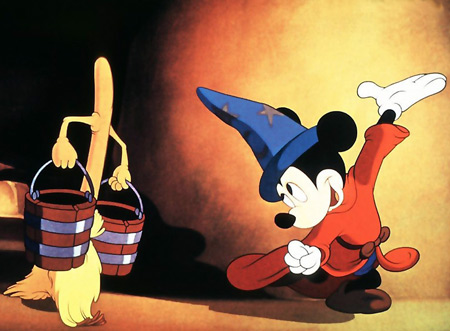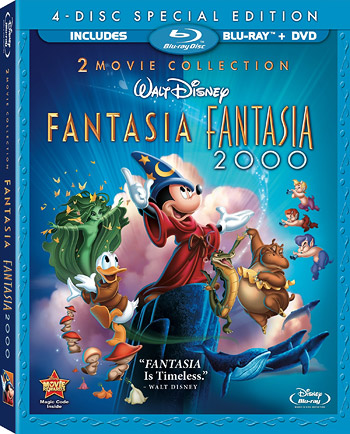
Coate: How is Fantasia significant within the animation genre?
Kurtti: Fantasia went so far beyond the standards of the day that it was well and truly “ahead of its time,” and “one of a kind.” It was a focused, courageous, and magnificent experiment in sight and sound, led by the passion and drive of Walt Disney himself; it not only pushed the art and techniques of animated filmmaking to new heights, the initial road show engagements featured the audio innovation of a stereophonic sound process known as “Fantasound.”
As an art work, past president of Disney Animation Thomas Schumacher summed up the collective of the film’s visual ambition quite succinctly: “Walt’s remarkable Fantasia was a stylistic profusion, featuring design elements derived from, and inspired by, the varied visions of Kay Neilsen, Oskar Fischinger, Heinrich Kley, choreographer George Balanchine, and even German Expressionist Cinema. There is nothing within this film that speaks to the mundane, in concept or appearance. These were extraordinary leaders of their time. It is cliché (and accurate) to say that nothing like it has happened since.”
Animation historian Charles Solomon assessed,” ... Fantasia may have been the most original and the most unusual project Disney ever undertook. It was basically a feature-length, studio experimental film. Until that time, the only idea of putting together animation and classical music had been in Europe with artists like Oskar Fischinger and Viking Eggeling… who were trying to bring movement to abstract painting. It was very much a high-art, high-culture, European phenomena. In the United States, classical music was part of the fine arts. It was something elevated, it was something cultural. Animation was something to amuse people in the theaters, in movie houses. Very different from an opera house or a concert hall. The idea that Disney could claim a place for this new art of animation as ranking with the traditional fine arts was almost sacrilegious.”
Coate: Where do you think Fantasia ranks among Walt Disney’s body of work?
Kurtti: Joe Grant said, “Everybody at the studio, all the big names, all were looking toward fine arts, to upward, to get out of the rut of the cartoon character. So that was an ambition and Walt was certainly in favor of it… You saw that in Fantasia.”
“For my medium it opens up unlimited possibilities,” Walt said of Fantasia. “Music has always played a very important part since sound came into the cartoon. Now, the full expression that comes from the new Fantasound opens up a whole new world for us. The music inspired the pictures.”
It represents Walt and his team at its most confident, secure, and curious. In this confluence of circumstance, the reputation of the Studio and its founder was at an all-time high, finances were stable, and the talent that had been gathered was unprecedented. Walt said simply, “…we just felt that… we could do some very exciting with music and picture and color and things, so we just went ahead and tried it out and as I see it, it was successful for what is was. Of course, it brought in the art side, it brought in the music side, it brought in the motion picture…”
Walt said later, “Well, Fantasia was made at a time when we had that feeling that we had to open the doors here—this medium was something we felt a responsibility for and we just felt that we could go beyond the comic strip, that we could do some very exciting with music and picture and color and things.”
Coate: Overall, Fantasia was unsuccessful on its initial release. Do you think Disney choosing to roadshow the film adversely affected its performance and public acceptance? Would it have been more effective in this instance for the film to have been released in a more conventional manner from the onset?
Kurtti: The risk of utter innovation is failure. Walt was actually really lucky enough to have had the opportunity to “fail” with Fantasia. Later in life he simply said, “Artistic success, financial failure.” Those cities where Fantasia was shown in its Roadshow version did very well in terms of attendance. In New York, Los Angeles, and other big cities, it enjoyed runs of many months.
Animator Ollie Johnston recalled that people who knew what Fantasia was, and what the experience was supposed to be, tended to enjoy it far more, and to appreciate it enormously.
The financial failure of Fantasia was two-fold, however. First, theatre leasing and installation of Fantasound was expensive, as was operation of the presentation. Its length also limited the number of daily performances. The war in Europe limited the distribution there, too. Ultimately, all but one of the Fantasound systems were dismantled for use in the war effort. Later, Fantasound creator Bill Garity also detailed some of the specific problems with the Roadshow:
- The amount of equipment required and the time necessary to make the installation.
- Because of the time element, attractive theaters were not available to Disney, as the first-class houses in the various communities had established policies and the installation of the equipment would generally require keeping the theater “dark” for a few days.
- The advent of wartime conditions precluded the possibility of developing mobile units that would have lessened installation time and costs.
- The variation in the regulations throughout the country, both as to operating personnel and local ordinances, materially affected the operating and installation costs.
- Limited space in many projection rooms was a major problem.
Naturally, Walt took away many lessons from this, too. One of them was his utter insistence on what would become known as “good show.” His Fantasia roadshow theatres were supervised and staffed by his people, with his training. The experience, from the moment a patron hit the sidewalk in front of the theatre, was exceptional. These ideas continued as he began his own distribution company in 1953, and with the “show” concepts of Disneyland in 1955.

Coate: What is the legacy of Fantasia?
Kurtti: Certainly the idea of visuals paired with music was one that Fantasia initiated, leading to similar elements in Disney’s “package features” and projects such as the Oscar-winning The Grand Canyon in 1959.
One might say that MTV and music video in the 1980s was a child or grandchild of Fantasia.
Certainly for animators and filmmakers it remains an important milestone film, and elements of it are still inspiring the aspirations of artists and creators today.
But a seldom-spoken part of the Fantasia legacy is the idea of what might have been.
As Ollie Johnston once said, “The big thing, personally, that I feel, with a little tear in my heart—where would we be today if that picture had been as successful as Walt had hoped it would be?”
Coate: Thank you, Jeff, for sharing your thoughts on Disney’s Fantasia on the occasion of the 75th anniversary of its release.
--END--
IMAGES
Selected images copyright/courtesy The Walt Disney Company.
SOURCES/REFERENCES
The primary references for this project were newspaper articles and advertisements archived on microfilm and the periodicals Boxoffice, The Film Daily, The Hollywood Reporter, Motion Picture Herald, and Variety.
SPECIAL THANKS
Jerry Alexander, Bill Kretzel, Jeff Kurtti, Mark Lensenmayer, Vince Young, and a thank-you to all of the librarians who helped with the research for this project.
- Michael Coate





